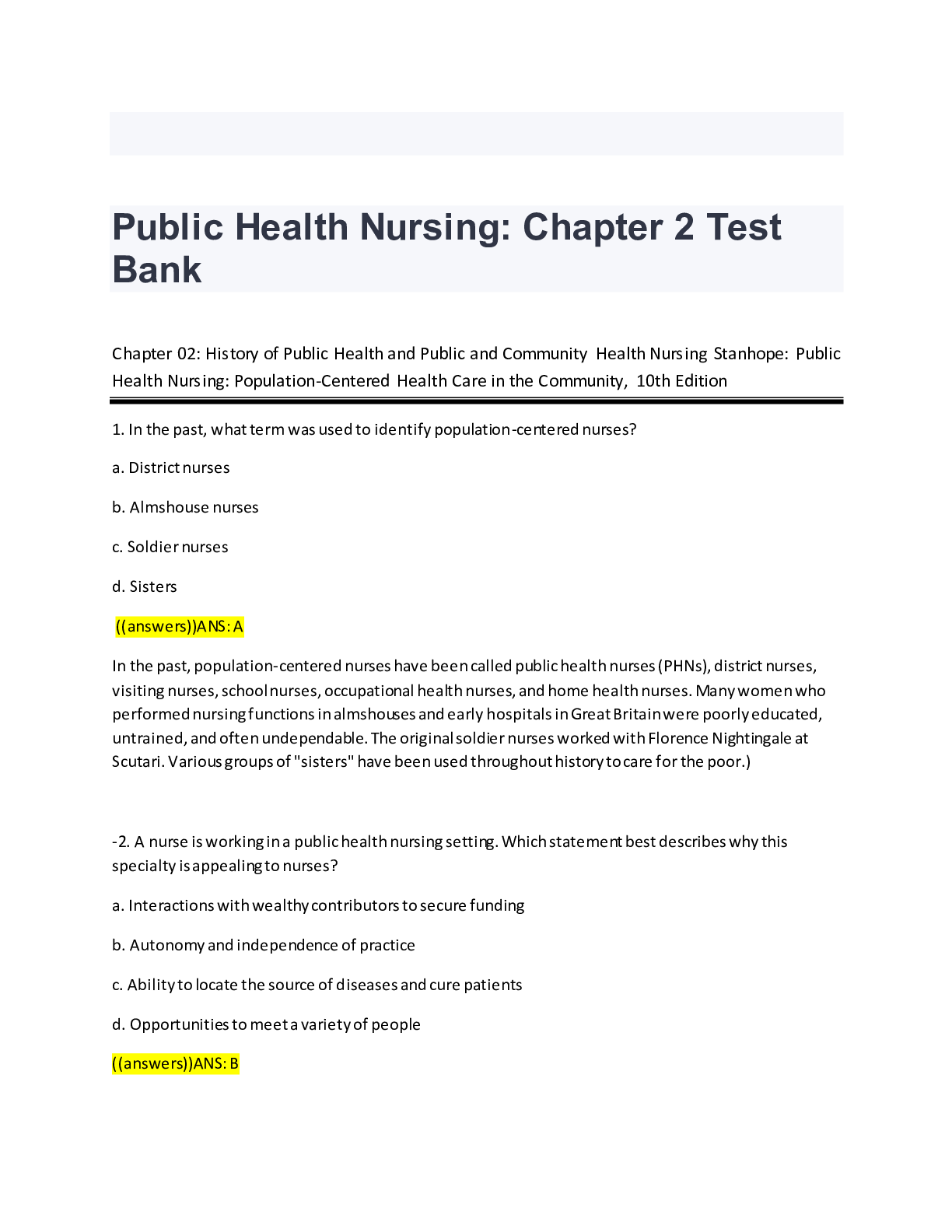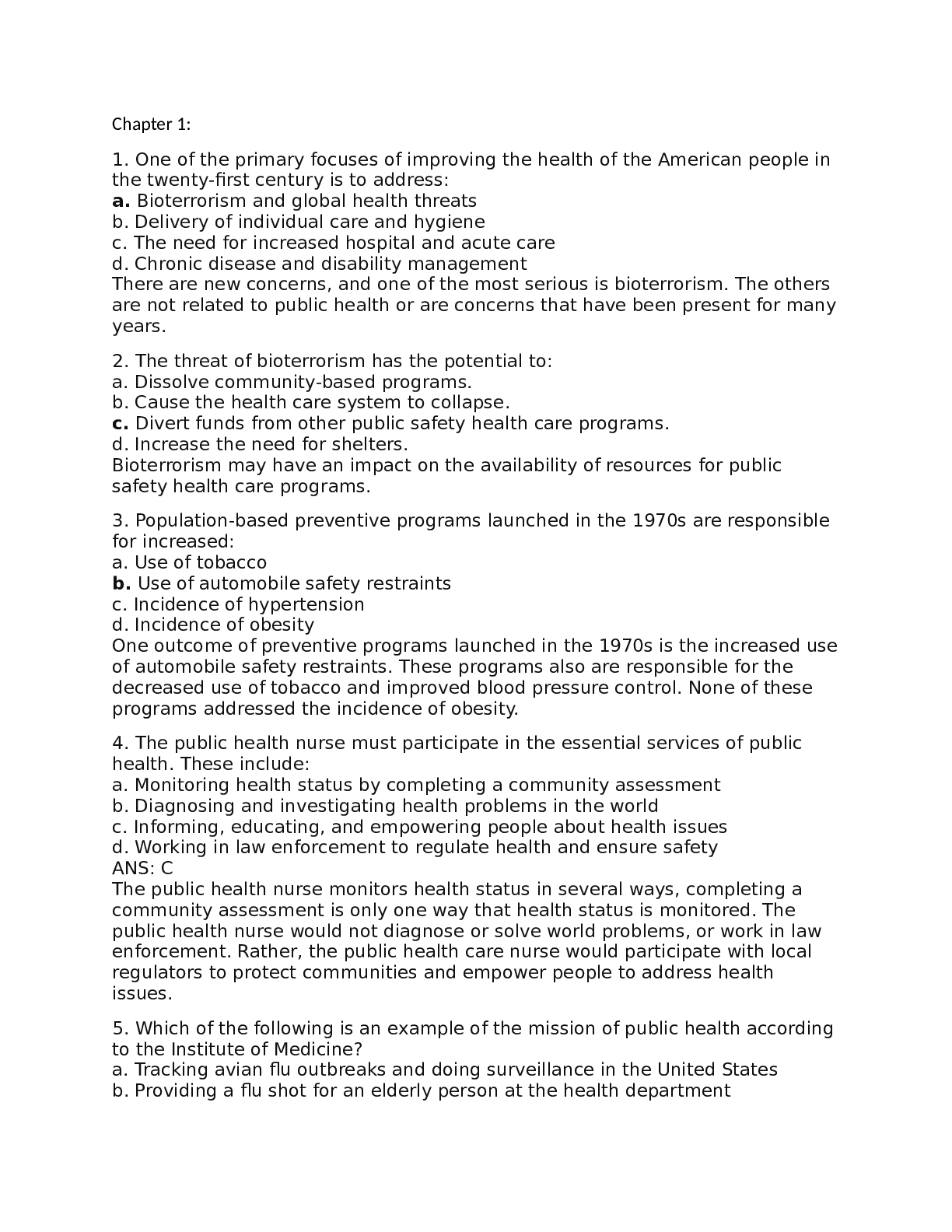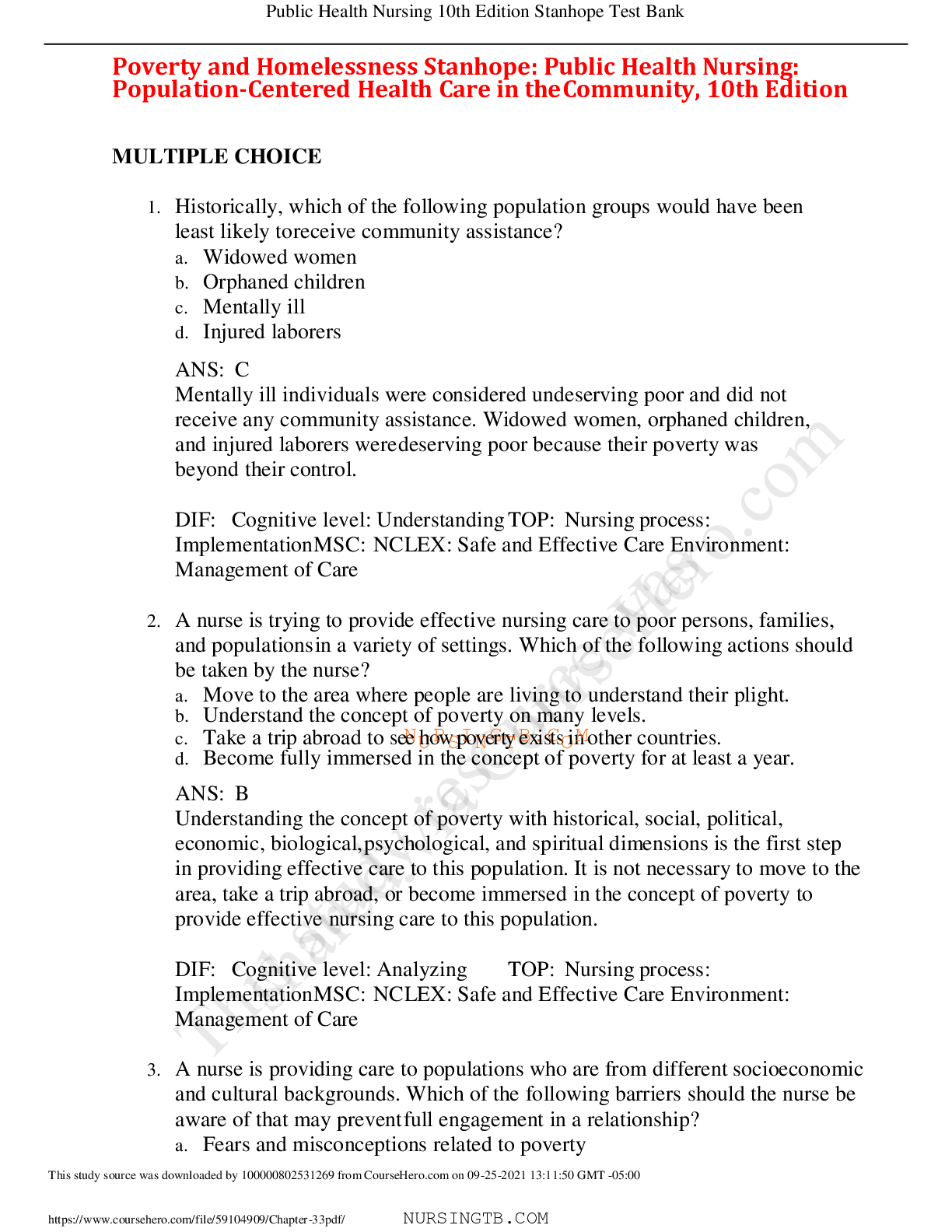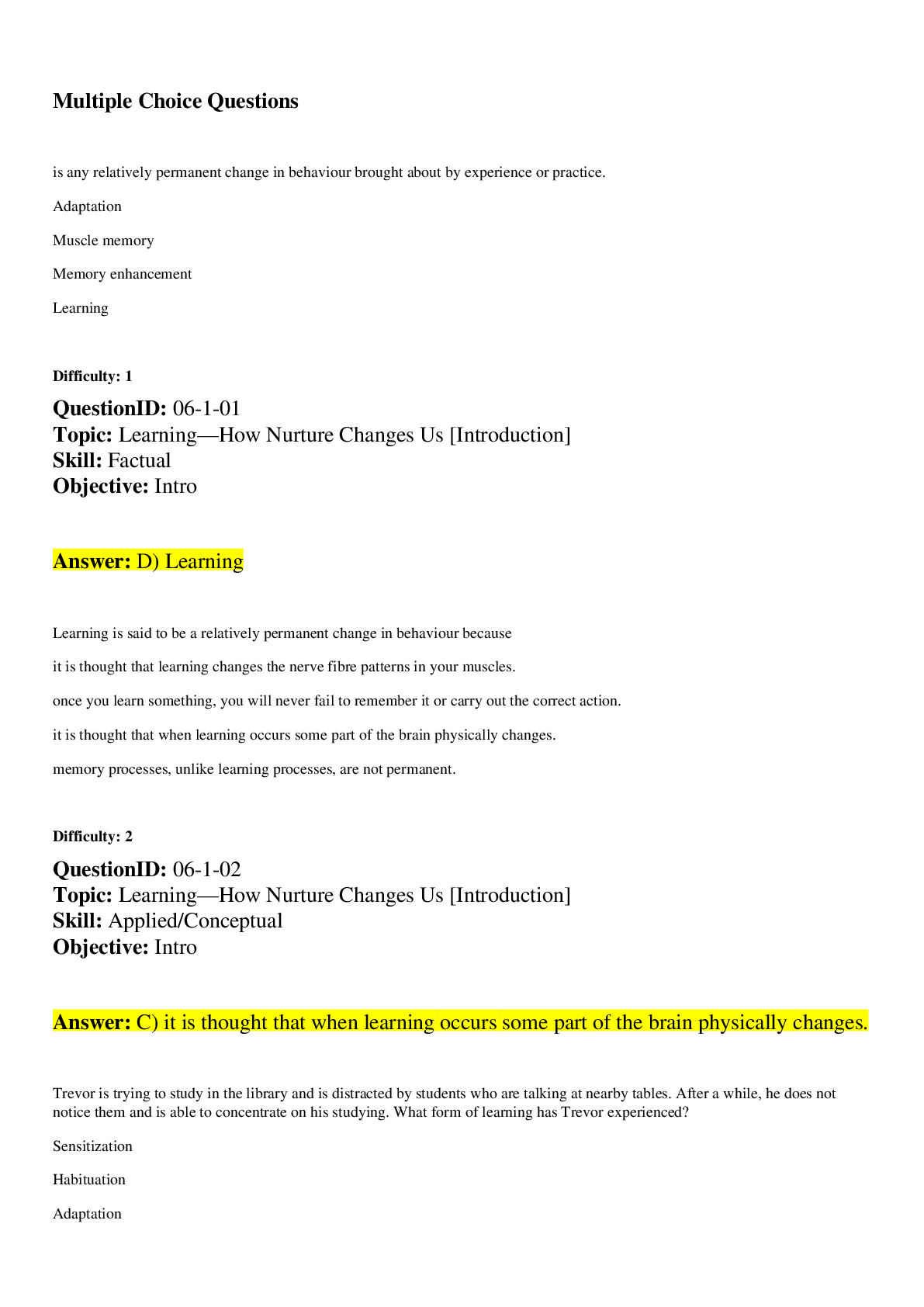*NURSING > TEST BANK > History of Public Health and Public and Community Health Nursing Stanhope: Public Health Nursing: Po (All)
History of Public Health and Public and Community Health Nursing Stanhope: Public Health Nursing: Population-Centered Health Care in the Community,10th Edition,100% CORRECT
Document Content and Description Below
History of Public Health and Public and Community Health Nursing Stanhope:: Population-Centered Health Care in the Community,10th Edition MULTIPLE CHOICE 1. In the past, what term was used to ... identify population-centered nurses? a. District nurses b. Almshouse nurses c. Soldier nurses d. Sisters ANS: A In the past, population-centered nurses have been called public health nurses (PHNs), district nurses, visiting nurses, school nurses, occupational health nurses, and home health nurses. Many women who performed nursing functions in almshouses and early hospitals in Great Britain were poorly educated, untrained, and often undependable. The original soldier nurses worked with Florence Nightingale at Scutari. Various groups of “sisters” have been used throughout history to care for the poor. DIF: Cognitive level: Remembering TOP: Nursing process: Assessment MSC: NCLEX: Safe and Effective Care Environment: Management of Care 2. A nurse is working in a public health nursing setting. Which statement best describes why this specialty is appealing to nurses? a. Interactions with wealthNyUcRonStrIibNuGtoTrsBto.sCecOuMre funding b. Autonomy and independence of practice c. Ability to locate the source of diseases and cure patients d. Opportunities to meet a variety of people ANS: B Community health nurses have a long history of autonomous practice, problem solving, and decision making. Community health care nurses engage in the other activities as well, but overall, they have been best known for autonomy of practice. DIF: Cognitive level: Understanding TOP: Nursing process: Assessment MSC: NCLEX: Safe and Effective Care Environment: Management of Care 3. What are the newest threats to health in the United States that community health nurses deal with? a. Diphtheria, cholera, and hepatitis b. HIV, influenza, and bioterrorism c. Avian flu, tuberculosis (TB), and radiation d. Polluted water and air ANS: B The newest threats to health that PHNs are involved in are HIV, H1N1 influenza, and bioterrorism. Hepatitis is also a current threat, but diphtheria and cholera are not concerns in the United States. Avian flu may be a threat, but radiation and TB are ongoing. Environmental pollution has been reduced; however, there are pollution issues that do raise concerns. DIF: Cognitive level: Understanding TOP: Nursing process: Assessment MSC: NCLEX: Safe and Effective Care Environment: Management of Care 4. A nurse is working to reform a program that was based on the Elizabethan Poor Law of 1601. Which of the following programs is the nurse most likely working on? a. Welfare b. Food Stamps c. Medicaid d. Medicare ANS: C The Poor Law guaranteed medical care for poor, blind, and “lame” individuals, making it most similar to Medicaid since this program provides medical insurance to these types of individuals. Welfare provides more than health care. Food stamps do not provide medical care. The Medicare program provides medical care to the elderly population. DIF: Cognitive level: Analyzing TOP: Nursing process: Implementation MSC: NCLEX: Safe and Effective Care Environment: Management of Care 5. In early colonial North America, a colonist worked in the public health sector. Which activity would have most liNkelyRbeIen tGhe fBoc.uCs? M a. Establishing schools of nursing b. Developing vaccines to administer to large numbers of people c. Collecting vital statistics and improving sanitation d. Developing public housing and almshouses ANS: C The early colonial public health efforts included the collection of vital statistics, improvements to sanitation systems, and control of communicable disease introduced through seaports. Establishing schools of nursing, developing vaccines, and developing public housing are all events that happened after the colonial period. DIF: Cognitive level: Remembering TOP: Nursing process: Assessment MSC: NCLEX: Health Promotion and Maintenance 6. A nurse was employed by the Marine Hospital Service. Which of the following tasks would have most likely been the responsibility of the nurse? a. Setting policy on quarantine legislation for immigrants b. Establishing hospital-based programs to care for the sick at home c. Identifying and improving environmental conditions d. Providing health care for merchant seamen ANS: D Providing health care to seamen was an early effort by the federal government to improve public health. The purpose of the Marine Hospital Service was to secure its maritime trade and seacoast cities. Marine Hospital Service nurses did not establish policies or hospital programs. They also did not identify and improve environmental conditions as Florence Nightingale did. Their sole purpose was to provide care for this population. DIF: Cognitive level: Applying TOP: Nursing process: Assessment MSC: NCLEX: Health Promotion and Maintenance 7. What was Florence Nightingale’s contributions to public health? a. Caring for the sick, poor, and neglected in institutions and at home b. Using a population-based approach that led to improved environmental conditions c. Writing the Elizabethan Poor Law to guarantee medical care for all d. Founding of the district nursing association to provide health care to needy people ANS: B During the Crimean War, Nightingale progressively improved the soldiers’ health by adopting a population-based approach that used simple epidemiological measures and greatly decreased mortality. The focus of her care was on wounded soldiers, not those who were sick, poor, and neglected at homes and institutions. She did not write the Elizabethan Poor Law. William Rathbone founded the district nursing association. DIF: Cognitive level: Remembering TOP: Nursing process: Assessment MSC: NCLEX: Health Promotion and Maintenance 8. What was Lillian Wald’s major contribution to public health nursing? a. Founding the AmericanNNuRrsesIAsGsocBiat.ioCn M b. Developing the New York Training Hospital for Nurses c. Creating the Public Health Service d. Establishing the Henry Street Settlement ANS: D Lillian Wald established the Henry Street Settlement. Isabel Hampton Robb founded the American Nurses Association. Lillian Wald was a graduate of the New York Training Hospital for Nurses. The Public Health Service was established by the federal government. DIF: Cognitive level: Remembering TOP: Nursing process: Implementation MSC: NCLEX: Health Promotion and Maintenance 9. A nurse is providing public health education based on the teachings of Lillian Wald. Which of the following topics will the nurse most likely discuss? a. Taking and recording blood pressures accurately b. Safe and sanitary baby and child care c. Environmental pollutants and their effects on lung disease d. Time management: balancing factory work and the home ANS: B Lillian Wald provided health care that included educating the community on health care matters. The focus of most of her work was on health services and health promotion for families and children. Because of her focus on health promotion for families and children, her primary role would not have been taking and recording blood pressures, discussing environmental pollutants (as her focus was not occupational health), or time management (at the time, very few women were working outside of the home). DIF: Cognitive level: Applying TOP: Nursing process: Implementation MSC: NCLEX: Health Promotion and Maintenance 10. Nurses who provided care to people in their homes were referred to as what type of nurses? a. Private duty b. Visiting c. Public health d. Community health ANS: B The visiting nurse cared for several families in a day and helped make care of the sick poor at home economical, whereas a private duty nurse may live with a family of clients receiving care and was to be available 24 hours a day. PHNs focused on care of populations. Community health nurses would be anyone who worked outside of a hospital setting. DIF: Cognitive level: Remembering TOP: Nursing process: Implementation MSC: NCLEX: Safe and Effective Care Environment: Management of Care 11. What term was used to identify neighborhood centers that provided health care, education, and social welfare programNs? R I G B.C M a. Settlement houses b. Nursing care centers c. Nurse-managed clinics d. Public health services (PHSs) ANS: A Settlement houses were neighborhood centers that provided health care, education, and social welfare programs. Nursing centers, nurse-managed clinics, and PHSs are not necessarily in neighborhoods. DIF: Cognitive level: Remembering TOP: Nursing process: Implementation MSC: NCLEX: Safe and Effective Care Environment: Management of Care 12. A nurse worked in a school setting during the early twentieth century. Which activity would have been the focus of this nurse’s practice? a. Investigating causes of absenteeism b. Teaching school as well as being a nurse c. Promoting nursing as an autonomous practice d. Providing medical treatment to enable children to return to school ANS: A Early school nursing focused on investigating causes of absenteeism, not providing medical treatment. That was the responsibility of physicians. Early school nurses did not teach in the schools. Early school nurses did not promote nursing as an autonomous practice. DIF: Cognitive level: Applying TOP: Nursing process: Implementation MSC: NCLEX: Health Promotion and Maintenance 13. The document Visiting Nursing in the United States highlighted the fact that: a. nurses were trained by Boards of Education. b. trained nurses adequately covered less densely populated areas. c. visiting nurse services were concentrated in the northeastern United States. d. nurses were curing diseases such as TB and typhoid fever. ANS: C This report emphasized the fact that visiting nurse services were concentrated in the northeast, which underscored the need for rural health. The document did not address how the nurses were educated or the diseases that nurses were curing. This report showed that there was not adequate coverage for nurses in less populated areas. DIF: Cognitive level: Remembering TOP: Nursing process: Assessment MSC: NCLEX: Safe and Effective Care Environment: Management of Care 14. During the time when the Rural Nursing Service was operating through the American Red Cross, a nurse needed to demonstrate resourcefulness. Which intervention would the nurse most likely have implemented? a. Using hot bricks, salt, or sandbags to substitute for hot water bottles b. Testing well water for pNolluRtanIts G B.C M c. Teaching school and developing curricula for rural nursing programs d. Providing post-surgical care ANS: A In providing medical care, rural nurses were resourceful in finding alternatives when they did not have medical products that were available in urban areas. They were not involved in testing well water, providing post-surgical care, or teaching in rural nursing programs. DIF: Cognitive level: Remembering TOP: Nursing process: Implementation MSC: NCLEX: Health Promotion and Maintenance 15. Local health departments were formed in urban areas in the late 1800s to accomplish what goal? a. Targeting environmental hazards associated with crowded living conditions b. Facilitating interdisciplinary efforts and promoting “practical nursing” c. Providing immunizations and health care services to all citizens d. Offering public health education to nurses who had finished basic training ANS: A Local health departments were formed to handle environmental issues in cities, including problems associated with crowded living conditions and dirty streets, and to regulate public baths, slaughterhouses, and pigsties. Because sanitation was such an issue, there was not a focus on interdisciplinary care, provision of immunizations, or public health education for nurses. DIF: Cognitive level: Understanding TOP: Nursing process: Implementation MSC: NCLEX: Safe and Effective Care Environment: Management of Care 16. A nurse was involved in the original work of the National Organization for Public Health Nursing. Which event best describes the influence this has had on nursing practice today? a. Requiring that public health nurses (PHNs) have a baccalaureate degree in nursing b. Standardizing public health nursing education c. Developing nursing cooperatives d. Opening the Henry Street Settlement ANS: B The National Organization for Public Health Nursing sought to standardize public health nursing. The Henry Street Settlement was already in existence. The baccalaureate degree in nursing was not developed yet. Cooperative agreements were made between life insurance companies and visiting nurses’ associations that expanded availability of public health nursing services. DIF: Cognitive level: Understanding TOP: Nursing process: Implementation MSC: NCLEX: Safe and Effective Care Environment: Management of Care 17. A nurse is considering joinNing Rthe IAmGericBan.PCublMic Health Association (APHA). What information about this organization should be considered when making this decision? a. APHA focuses on the public health concerns of the medical profession. b. APHA represents concerns of nursing specialty practices. c. APHA provides a forum for nurses to discuss their public health concerns. d. APHA focuses on providing health promotion education to the public. ANS: C APHA was formed to facilitate interprofessional efforts and promote the “practical application of public hygiene.” The Public Health Section within APHA provides nurses with a forum to discuss their concerns and strategies. It also serves as a focus of leadership and policy development for community/public health nursing. DIF: Cognitive level: Understanding TOP: Nursing process: Assessment MSC: NCLEX: Safe and Effective Care Environment: Management of Care 18. Historically, which statement is true about African American nurses in public health? a. Certificate and graduate education were more difficult to obtain. b. Segregation limited areas where they practiced. c. They often belonged to the Frontier Nursing Service (FNS). d. They were recruited heavily as military nurses. ANS: A Due to segregation, certification and graduate education were more difficult to obtain. They were faced with many challenges because of discrimination and had a limited presence in public health nursing practice. They were not part of the FNS or recruited as military nurses. DIF: Cognitive level: Understanding TOP: Nursing process: Assessment MSC: NCLEX: Safe and Effective Care Environment: Management of Care 19. A nurse working with Mary Breckinridge, would likely have assisted with what activity? a. Establishing the Henry Street Settlement b. Developing health programs geared toward improving the health care of the rural populations c. Blazing a nursing trail through the Rockies, providing nursing care to miners and their families d. Teaching birth control measures to large numbers of women in the South ANS: B Mary Breckinridge developed health programs geared toward improving the health care of the rural and often inaccessible populations in the Appalachian regions of southern Kentucky. Lillian Wald established the Henry Street Settlement. DIF: Cognitive level: Understanding TOP: Nursing process: Implementation MSC: NCLEX: Health Promotion and Maintenance 20. A nurse providing care through the Frontier Nursing Service (FNS), would most likely have addressed the needs of which client? a. An injured soldier b. A homebound, elderly NmalRe I G B.C M c. A woman in labor d. A child with measles ANS: C The FNS nurses were trained in nursing public health and midwifery and provided care to rural and inaccessible areas, which led to reduced mortality. They would not have seen injured soldiers, males, or a child with measles. DIF: Cognitive level: Remembering TOP: Nursing process: Implementation MSC: NCLEX: Safe and Effective Care Environment: Management of Care 21. A major provision of the Social Security Act of 1935 was the establishment of which service? a. Frontier Nursing Service (FNS) to provide nursing service to rural communities b. State and local community health services and training of personnel c. District nursing to provide home health care to sick people d. Community-based settlement houses ANS: B Title VI of the Social Security Act provided funding for expanded opportunities for health protection and promotion through education and employment of PHNs. Nurses completed educational programs in public health and funds were provided to assist states, counties, and medical districts in the establishment and maintenance of adequate health services. DIF: Cognitive level: Remembering TOP: Nursing process: Assessment MSC: NCLEX: Safe and Effective Care Environment: Management of Care 22. A student is enrolled in a nursing education program during World War II. Which group would the student most likely have joined? a. The Public Health Service of New York City b. The Marine Nurse Corps c. The Frontier Nursing Service (FNS) d. The Cadet Nurse Corps ANS: D The Bolton Act of 1943 established the Cadet Nurse Corps during World War II, which increased enrollment in schools of nursing at undergraduate and graduate levels. In 1925, Mary Breckinridge established the FNS based on systems of care used in the Highlands and islands of Scotland (before World War II). The first Marine Hospital opened in Norfolk, Virginia, in 1800. The Public Health Service of New York City was not a group during this time frame. DIF: Cognitive level: Analyzing TOP: Nursing process: Implementation MSC: NCLEX: Safe and Effective Care Environment: Management of Care 23. Which statement best describes one of the health trends that occurred in the United States between 1900 and 1955? a. There was a rise in heart disease and cancer. b. There was a rise in communicable disease. c. The crude mortality ratNe inRcreaIsedGdraBm.atCicallMy. d. The life span after diagnosis remained the same. ANS: A Leading causes of death in 1955 were heart disease, cancer, and cerebrovascular disease, whereas in 1900 they were pneumonia, TB, and diarrhea/enteritis. The mortality rate decreased by 47%. There was a decrease in communicable disease, and the life span after diagnosis increased. DIF: Cognitive level: Understanding TOP: Nursing process: Assessment MSC: NCLEX: Safe and Effective Care Environment: Management of Care 24. A public health nurse (PHN) is compiling information about how to promote early detection of breast cancer in women. Which document would most likely provide useful information about this topic? a. The Future of Public Health b. Healthy People 2020 c. Patient Protection and Affordable Care Act d. Scope and Standards of Public Health Nursing Practice ANS: B The Healthy People documents propose national strategies to improve significantly the health of Americans by preventing or delaying the onset of major chronic illnesses, injuries, and infectious diseases. The other documents do not address health promotion topics. DIF: Cognitive level: Understanding TOP: Nursing process: Assessment MSC: NCLEX: Health Promotion and Maintenance 25. A neighborhood health center is researching its origins. Which legislative act most likely provided funds for its development? a. Emergency Maternity and Infant Care Act of 1943 b. Medicaid legislation c. Social Security Act of 1935 d. Economic Opportunity Act ANS: D Funding for neighborhood health centers, Head Start, and other community action programs began in 1964 with the Economic Opportunity Act. The Social Security Act of 1935 expanded opportunities for health protection and promotion through education and employment of PHNs. Medicaid legislation focused on medical care insurance for the poor. The Emergency Maternity and Infant Care Act of 1943 provided funding for medical, hospital, and nursing care for the wives and babies of servicemen. DIF: Cognitive level: Remembering TOP: Nursing process: Assessment MSC: NCLEX: Safe and Effective Care Environment: Management of Care 26. A 66-year-old person is retired and no longer has health insurance. Which of the following programs would be appropriate for his or her health insurance needs? a. Medicare b. Medicaid c. Social Security NURSINGTB.COM d. Economic Opportunity Act ANS: A The Social Security Act was amended to include health insurance benefits for the elderly, which is addressed through Medicare. Medicaid focuses on care for the poor. Social Security does not provide health insurance. The Economic Opportunity Act provided funding for neighborhood health centers, Head Start, and other community action programs. DIF: Cognitive level: Analyzing TOP: Nursing process: Planning MSC: NCLEX: Safe and Effective Care Environment: Management of Care 27. A public health nurse (PHN) becomes involved in health care reform. Which of the following best describes the purpose of this action? a. Promotion of the nursing profession b. Increases funding for public health nursing c. Addresses the concerns of nurses d. Improves health care access and reduce health care costs ANS: D PHNs have been involved in health care reform for several years. An emphasis of reform is that health promotion and disease prevention appear to yield reduction in costs and illness/injury incidence while increasing years of healthy life. The focus of health care reform is not on nursing, but rather the population as a whole. DIF: Cognitive level: Understanding TOP: Nursing process: Implementation MSC: NCLEX: Safe and Effective Care Environment: Management of Care MULTIPLE RESPONSE 1. The impact of World War I on public health nursing included which of the following? (Select all that apply.) a. Many communicable diseases were eradicated. b. The ranks of public health nurses (PHNs) depleted because many went off to war. c. The feeling that the greatest patriotic duty was to stay at home. d. Expanding nursing services in the community was limited by lack of funding. e. More women entered the public health nursing workforce. ANS: B, C, D Both World Wars I and II depleted the PHN population as nurses went off to war. The feeling of patriotism extended to the idea that patriotic duty could also be served on the home front. There was not an eradication of communicable diseases; rather, there was a worldwide influenza pandemic that swept through the United States, killing many people. Inadequate funding was the major obstacle to extending nursing services in the community. DIF: Cognitive level: Understanding TOP: Nursing process: Assessment MSC: NCLEX: Safe and Effective Care Environment: Management of Care NURSINGTB.COM [Show More]
Last updated: 1 year ago
Preview 1 out of 19 pages

Buy this document to get the full access instantly
Instant Download Access after purchase
Add to cartInstant download
We Accept:

Reviews( 0 )
$16.00
Document information
Connected school, study & course
About the document
Uploaded On
Sep 25, 2021
Number of pages
19
Written in
Additional information
This document has been written for:
Uploaded
Sep 25, 2021
Downloads
0
Views
46










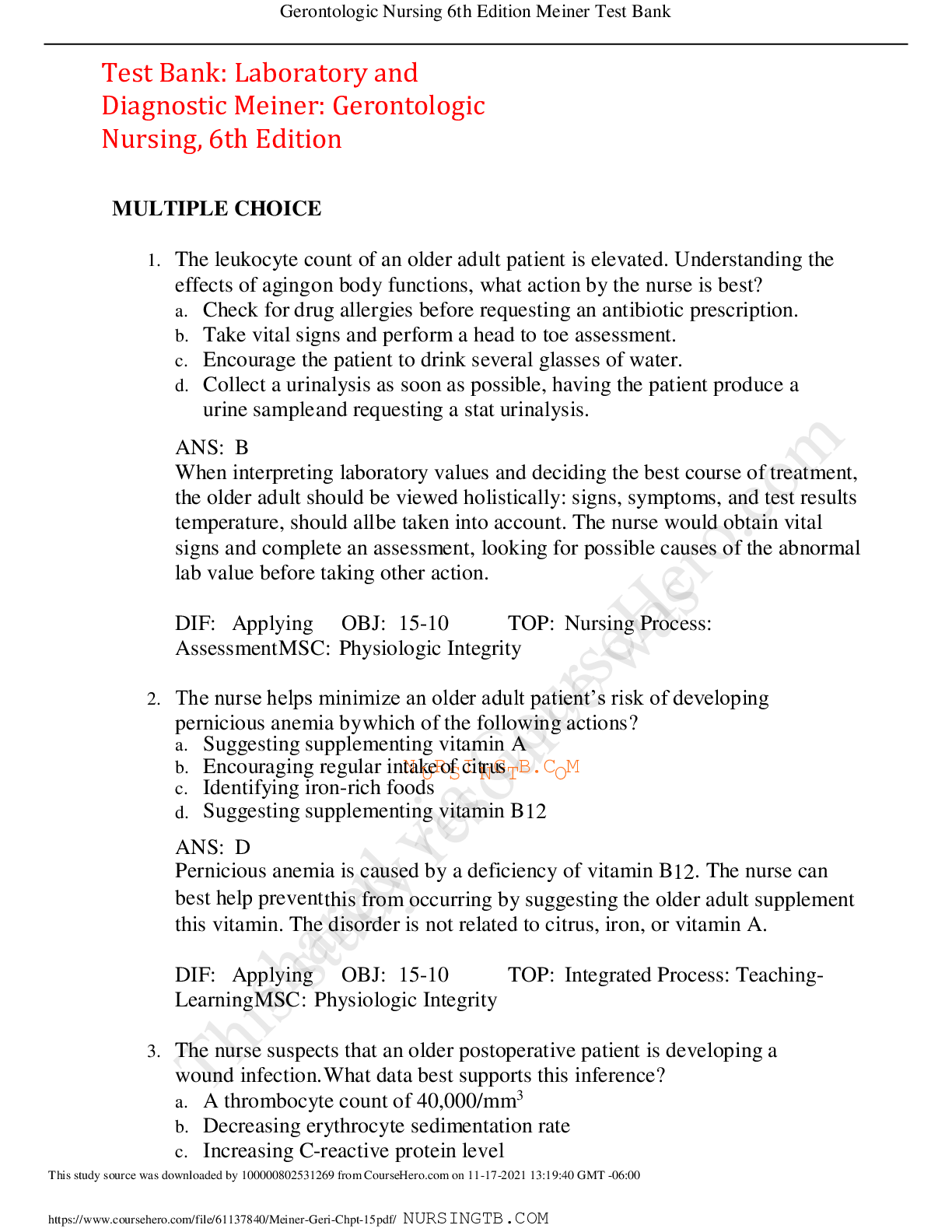



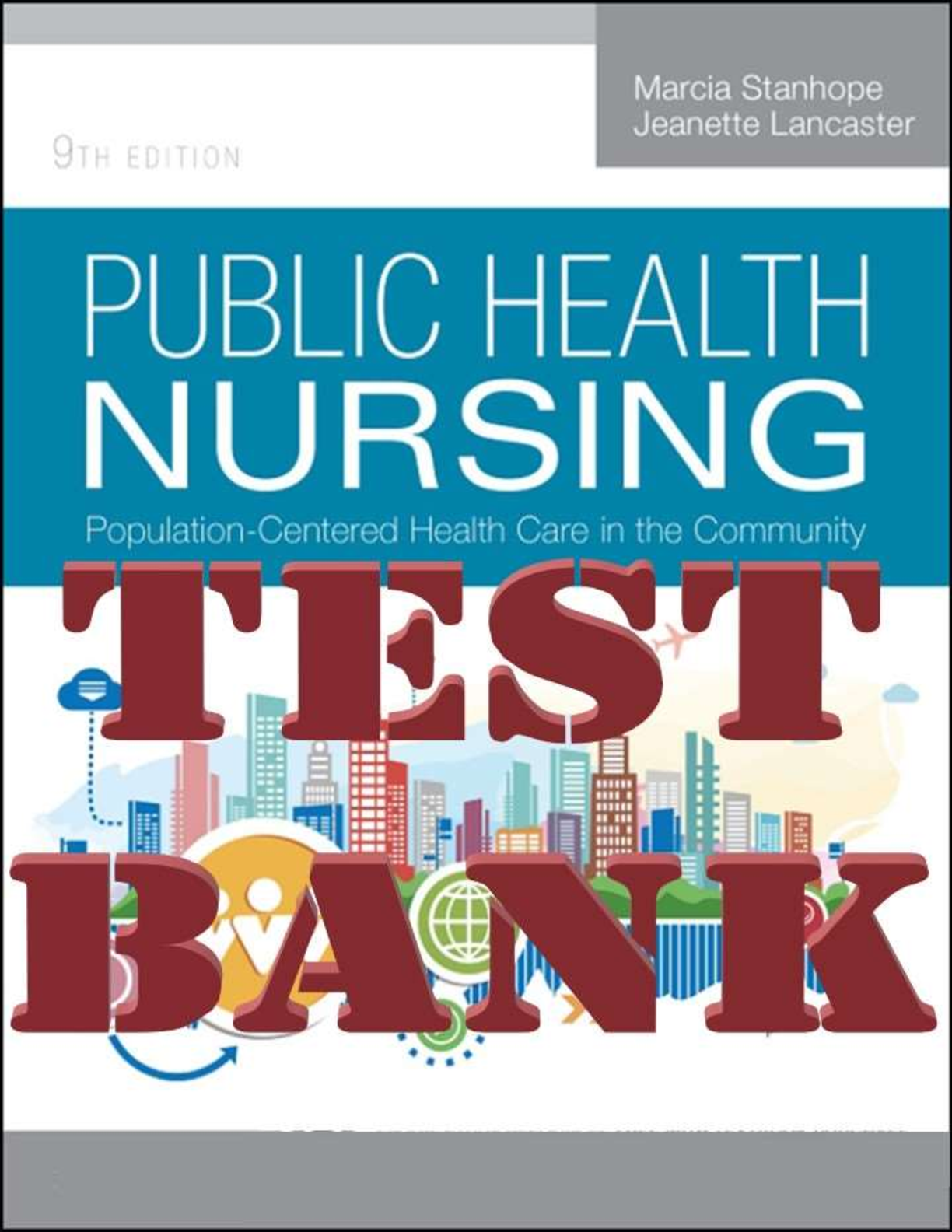

.png)
